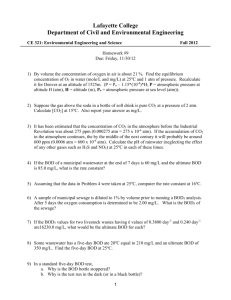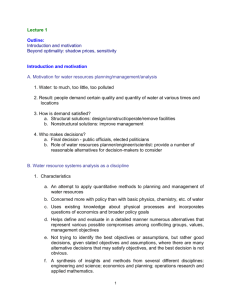Introduction
advertisement
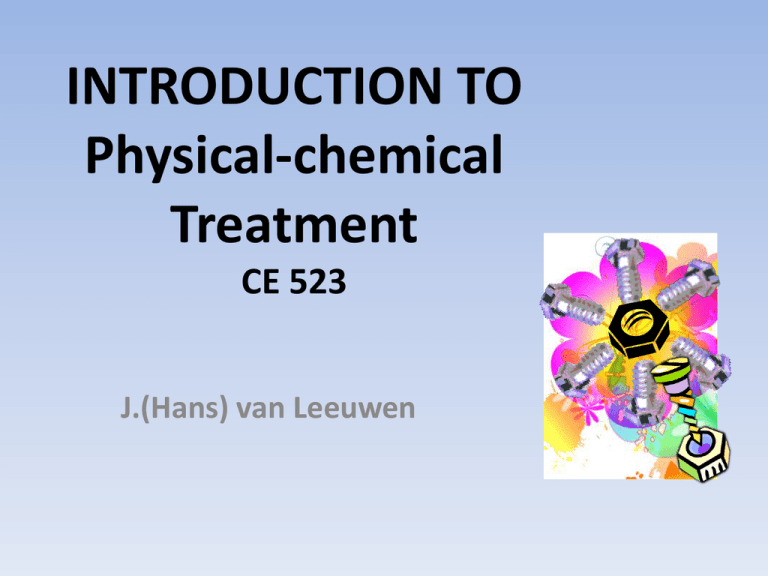
INTRODUCTION TO Physical-chemical Treatment CE 523 J.(Hans) van Leeuwen Instructor (33%) Professor J. (Hans) van Leeuwen from/of the Lions • • • • Born in Gouda, Netherlands Grew up in South Africa Lived in Australia for 7 years Lived in Ames for 11 years Specialty: Environmental and Bioengineering Industrial wastewater treatment and product development based on waste materials Research activities Beneficiation of biofuel coproducts by cultivating fungi Ozonation applications Selective disinfection Selective oxidation Alcohol purification Keeping exotic aliens out of our ports ET Zebra mussels Human technological development From scavengers… …to use of fire… Use of fire was the turning point in the technological development of humans leading to extended diet food preservation better hunting agriculture industry Top of the food chain! but, this ultimately led to… …Overpopulation… P o l l u t i o n . . Pollution of a small stream Consequence of pollution …and ecological disasters …and more disasters Distribution of Earth’s water Dangers lurking in water Pollution from informal housing Waterborne diseases Map by Lord John Snow of the cholera outbreak in London in 1854 – the Broad Street Epidemic. This is considered the root of epidemiology. Spread of Cholera in London 1854 1-3 September: 127 dead By 10 September: 500 Ultimately: 616 dead Cholera – the rapid killer SEM micrograph of Vibrio cholerae, a Gram-negative bacterium that produces cholera toxin, an enterotoxin, which acts on the mucosal epithelium lining of the small intestine This is responsible for the disease's most salient characteristic, exhaustive diarrhea. Bottom: cholera toxin Examples of organisms secreting enterotoxins Bacterial Escherichia coli O157:H7 Clostridium perfringens Vibrio cholerae Yersinia enterocolitica Shigella dysenteriae Staphylococcus aureus (pictured) Viral Rotavirus (NSP4) (Institute for Molecular Virology. WI) Dissolved oxygen Importance Why is oxygen in water important? Dissolved oxygen (DO) analysis measures the amount of gaseous oxygen (O2) dissolved in an aqueous solution. Oxygen gets into water by diffusion from the surrounding air, by aeration (rapid movement), and as a product of photosynthesis. DO is measured in standard solution units such as milligrams O2 per liter (mg/L), millilitres O2 per liter (ml/L), millimoles O2 per liter (mmol/L), and moles O2 per cubic meter (mol/m3). DO is measured by way of its oxidation potential with a probe that allows diffusion of oxygen into it. The saturation solubility of oxygen in wastewater can be expressed as Cs = (0.99)h/88 x 482.5/(T + 32.6) For example, in freshwater in Ames at 350m and 20°C, O2 saturation is 8.8 mg/L. (Check for yourself, with = 1) BOD Biochemical oxygen demand or BOD is a procedure for determining the rate of uptake of dissolved oxygen by the organisms in a body of water BOD measures the oxygen uptake by bacteria in a water sample at a temperature of 20°C over a period of 5d in the dark. The sample is diluted with oxygen saturated de-ionized water, inoculating it with a fixed aliquot of microbial seed, measuring the (DO) and then sealing the sample to prevent further oxygen addition. The sample is kept at 20 °C for five days, in the dark to prevent addition of oxygen by photo-synthesis, and the dissolved oxygen is measured again. The difference between the final DO and initial DO is the BOD or, BOD5. Once we have a BOD5 value, it is treated as just a concentration in mg/L BOD can be calculated by: Diluted: ((Initial DO - Final DO + BOD of Seed) x Dilution Factor BOD of seed (diluted activated sludge) is measured in a control: just deionized water without wastewater sample. Significance: BOD is a measure of organic content and gives an indication on how much oxygen would be required for microbial degradation. Oxygen depletion in streams DO sag definitions Cumulative oxygen supply + demand Plotting the two kinetic equations separately on a cumulative basis and adding these graphically produce the DO sag curve Streeter-Phelps Model* Mass Balance for the Model Not a Steady-state situation rate O2 accum. = rate O2 in – rate O2 out + produced – consumed rate O2 accum. = rate O2 in – 0 + 0 – rate O2 consumed Kinetics Both reoxygenation and deoxygenation are 1st order * Streeter, H.W. and Phelps, E.B. Bulletin #146, USPHS (1925) Kinetics* for Streeter-Phelps Model • Deoxygenation L dL/dt dL/dt k1 = = = = BOD remaining at any time Rate of deoxygenation equivalent to rate of BOD removal -k1L for a first order reaction deoxygenation constant, f’n of waste type and temp. t dL k dt 0 L d [ L] kL dt L ln kt or L0 L kt e L L0 e kt L0 C C0 *See Kinetics presentation if unfamiliar with the mathematical processing Developing the Streeter-Phelps Rate of reoxygenation = k2D D = deficit in D.O. k2 = reoxygenation constant* k2 3.9v 1 2 1.025 (T 20 ) H 3 1 Where 2 2 – T = temperature of water, ºC – H = average depth of flow, m – ν = mean stream velocity, m/s D.O. deficit = saturation D.O. – D.O. in the water There are many correlations for this. The simplest one, used here, is from O’Connor and Dobbins, 1958 Typical values for k2 at 20 °C, 1/d (base e) are as follows: small ponds and back water 0.10 - 0.23 sluggish streams and large lakes 0.23 - 0.35 large streams with low velocity 0.35 - 0.46 large streams at normal velocity 0.46 - 0.69 swift streams 0.69 - 1.15 rapids and waterfalls > 1.15 Combining the kinetics Net rate of change of oxygen deficiency, dD/dt dD/dt = k1L - k2D where L = L0e-k1t OR dD/dt = k1L0e-k1t - k2D Integration and substitution The last differential equation can be integrated to: k1Lo k1t k 2t k 2t D (e e ) Do e k2 k1 It can be observed that the minimum value, Dc is achieved when dD/dt = 0: dD k1 Lo e k1t k 2 D 0 dt k1 k1t Dc Lo e , since D is then Dc k2 Substituting this last equation in the first, when D = Dc and solving for t = tc: k2 Do (k 2 k1 ) 1 tc ln 1 k 2 k1 k1 k1 Lo Example: Streeter-Phelps Wastewater mixes with a river resulting in a BOD = 10.9 mg/L, DO = 7.6 mg/L The mixture has a temp. = 20 C Deoxygenation const.= 0.2 day-1 Average flow = 0.3 m/s, Average depth = 3.0 m DO saturated = 9.1 mg/L • Find the time and distance downstream at which the oxygen deficit is a maximum • Find the minimum value of DO Solution…some values needed • Initial Deficit Do = 9.1 – 7.6 = 1.5 mg/L (Now given, but could be calculated from proportional mix of river DO, presumably saturated, and DO of wastewater, presumably zero) • Estimate the reaeration constant: k2 = 3.9 v½ (1.025T-20)½ H3/2 k2 = 3.9 x (0.3m/s)½ (1.02520-20)½ (3.0m)3/2 = 0.41 d-1 Solution…time and distance k 2 DOo (k 2 k1 ) 1 tc ln 1 k 2 k1 k1 k1 Lo 0.41 1.5(0.41 0.2) 1 ln 1 (0.41 0.2) 0.2 0.2 10.9 2.67days xc vtc 0.3m / s 86,400s / day 2.67days 69,300m Note that the effects will be maximized almost 70 km downstream Solution…maximum DO deficiency k1 k1t Dc Lo e k2 Note that this BOD could have been calculated from mixing high-BOD wastewater with zero or near-zero BOD 0.2 (0.2day1 )(2.67days) (10.9 mg/L) e 0.41 3.1 mg/L The minimum DO value is 9.1-3.1 = 6 mg/L Implication: DO probably not low enough for a fishkill, but if continued could lead to species differentiation and discourage sensitives species like trout.


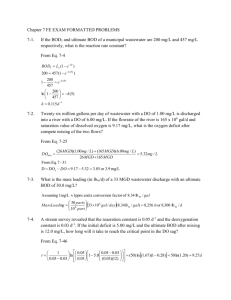
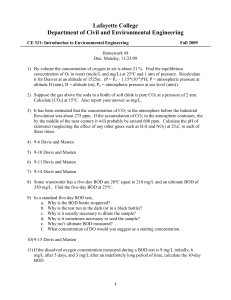
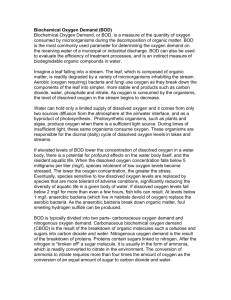
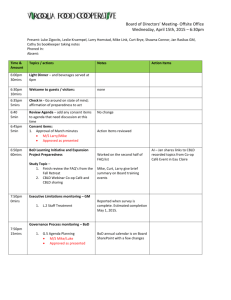
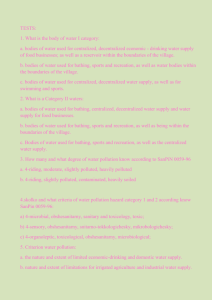

![Crisis Communication[1] - NorthSky Nonprofit Network](http://s2.studylib.net/store/data/005428035_1-f9c5506cadfb4c60d93c8edcbd9d55bf-300x300.png)

